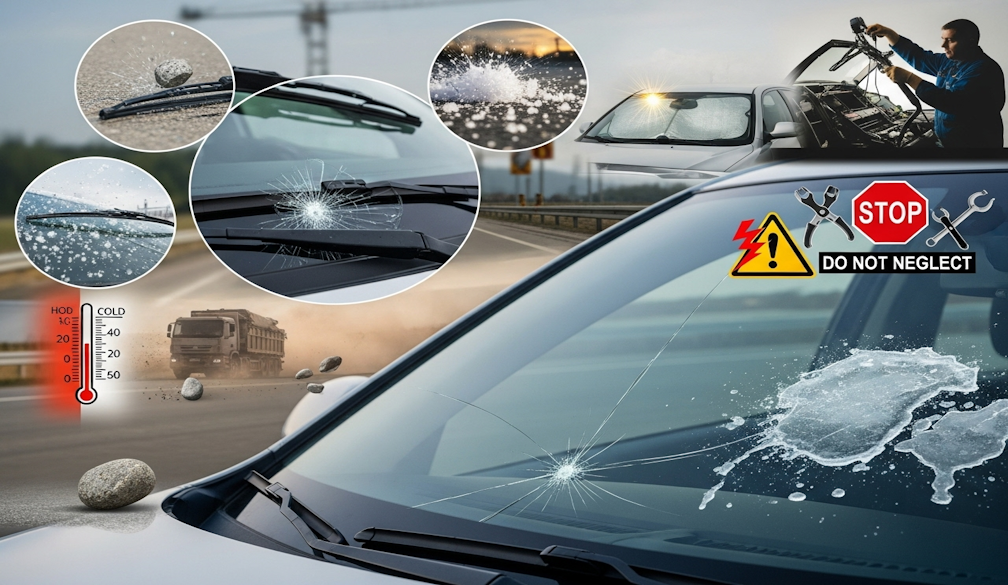Common Causes of Car Window Damage and How to Prevent Them

Car windows play a vital role in keeping drivers safe and comfortable, providing clear visibility and protecting passengers from the elements. Yet despite their strength, vehicle windows and windscreens are vulnerable to a range of everyday hazards. Chips, cracks, and scratches can appear suddenly — and if left unaddressed, they can compromise safety and lead to costly replacements.
Understanding the most common causes of car window damage and taking simple preventative measures can help extend the life of your vehicle’s glass and reduce the need for frequent automotive window repair.
1. Road Debris and Loose Gravel
One of the leading causes of car window and windscreen damage is debris kicked up from the road. Small stones, gravel, or other loose materials can easily strike your glass at high speed, causing chips or hairline cracks. This type of damage is especially common on highways and construction zones where debris is abundant.
Prevention tip: Keep a safe distance between your car and the vehicle in front, particularly trucks or utes that might flick up stones. Avoid driving too fast on newly surfaced or unsealed roads, where loose materials are more likely to cause impact damage.
2. Sudden Temperature Changes
Glass expands and contracts when exposed to heat and cold. Rapid temperature fluctuations — such as blasting the air conditioning on a hot day or pouring warm water on a frozen windscreen — can cause stress cracks to form. Even minor imperfections in the glass can quickly worsen under these conditions.
Prevention tip: Try to regulate the temperature changes your glass is exposed to. In winter, use your vehicle’s defroster gradually to warm the windscreen instead of applying direct heat. In summer, park in shaded areas or use a reflective sunshade to reduce heat build-up.
3. Accidents and Collisions
Even a minor collision or a heavy door slam can put stress on your vehicle’s windows and windscreen. Cracks and chips may not appear immediately but can develop over time as the structural integrity of the glass weakens.
Prevention tip: Drive defensively and be cautious in car parks, where low-speed collisions are common. Regularly inspect your windows after any incident, even if the damage seems minimal. Early detection makes repair easier and prevents small cracks from spreading.
4. Poor Installation or Previous Repairs
Improper installation or low-quality repair work can leave glass vulnerable to stress points, leaks, or weak seals. Over time, vibrations from driving can worsen these issues, leading to chips or cracks around the edges of the glass.
Prevention tip: Always choose a trusted professional for installation or repair. Reputable technicians use high-quality materials and adhesives designed to withstand temperature changes, pressure, and vibration — ensuring your glass remains secure and durable.
5. Vandalism and Theft Attempts
Unfortunately, deliberate damage such as vandalism or attempted break-ins is another common cause of window damage. Thieves may strike at side windows to access vehicles quickly, leaving behind shattered or weakened glass.
Prevention tip: Park in well-lit, secure areas whenever possible, and avoid leaving valuables in plain sight. Installing an alarm system or motion-detection camera can also deter theft and vandalism.
6. Weather and Environmental Factors
Hailstorms, flying branches, and high winds can all cause unexpected damage to your car’s windows. In coastal areas, salt air can also contribute to the slow deterioration of seals, increasing the likelihood of leaks and cracks.
Prevention tip: If a storm is forecast, park your vehicle in a garage or under cover. For those living in coastal or windy regions, regularly clean your windows and seals to remove dirt, salt, and debris that can accelerate wear.
7. Neglecting Small Damage
Perhaps the most preventable cause of window replacement is failing to act on minor damage. A tiny chip might seem harmless at first, but vibration, moisture, and temperature changes can cause it to spread into a large crack — one that requires a full glass replacement.
Prevention tip: Schedule repairs as soon as you notice any damage. Professional technicians can usually fix small chips quickly and affordably, restoring strength and clarity to your glass before the problem worsens.
The Importance of Professional Repairs
While DIY solutions might seem convenient, professional automotive window repair ensures your glass is restored safely and effectively. Certified technicians use specialised tools and resins that maintain the structural integrity of the window, preventing future issues.
Prompt, professional repairs don’t just save you money — they also preserve the safety of your vehicle by maintaining clear visibility and preventing weakened glass from shattering under pressure.
Final Thoughts
Car window damage can happen in an instant, but with a few mindful habits, it’s possible to prevent most issues. By driving carefully, avoiding extreme temperature changes, and addressing even minor chips quickly, you can protect your car’s glass and extend its lifespan.
When damage does occur, choosing expert automotive window repair is the best way to keep your vehicle safe, functional, and looking its best for years to come.





